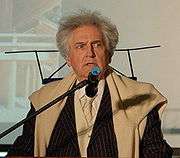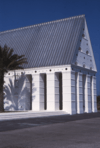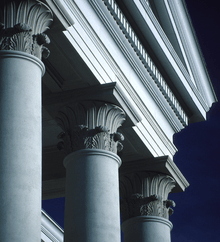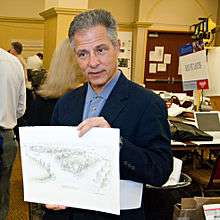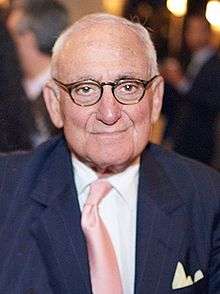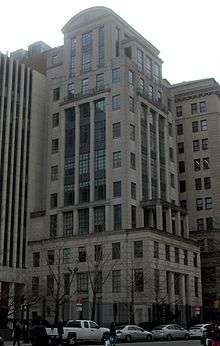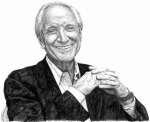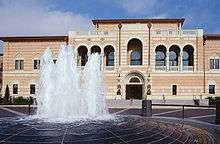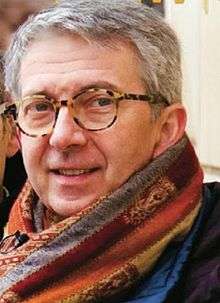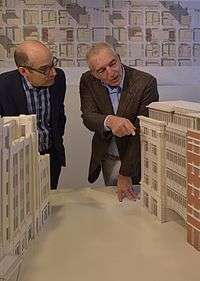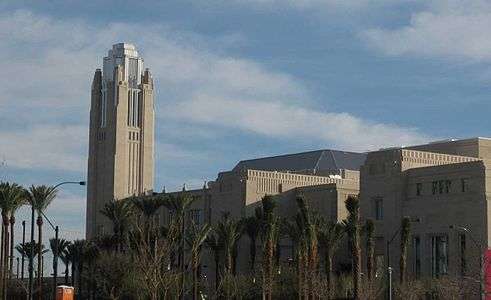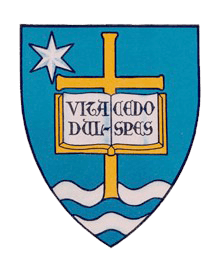Driehaus Architecture Prize
| Driehaus Architecture Prize | |
|---|---|
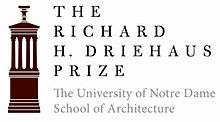 | |
| Awarded for | A career of achievement in the art of classical architecture. |
| Sponsored by | The Richard H. Driehaus Charitable Lead Trust |
| Reward(s) | US$200,000[1] |
| First awarded | 2003 |
| Last awarded | 2015 |
| Official website |
www |
The Driehaus Architecture Prize, fully named The Richard H. Driehaus Prize at the University of Notre Dame, is a global award to honor a major contributor in the field of contemporary vernacular and classical architecture, commonly referred to as New Classical architecture.
It was initiated by philanthropist Richard Driehaus and established in 2003 by The Richard H. Driehaus Charitable Lead Trust. It is presented annually through the Notre Dame School of Architecture, a faculty of the University of Notre Dame in Indiana, United States. The Driehaus Prize is an alternative to the predominantly modernist Pritzker Prize.
The most recent winner is Scott Merrill, who was officially awarded on March 19, 2016 in Chicago.[2]
Outline
The Driehaus Prize is awarded to a living architect whose work embodies the principles of traditional and classical architecture and urbanism in contemporary society, and reflects what the jury considers positive cultural, environmental and artistic impacts. The award itself is a bronze miniature of the Choragic Monument of Lysicrates, known as the first use of the Corinthian order on the outside of a building.[3] The award includes a monetary prize of US$200,000.
The Henry Hope Reed Award is given in conjunction with the Driehaus Prize to an individual working outside the practice of architecture who has supported the cultivation of the traditional city, its architecture and art through writing, planning or promotion.[4]
Jury
A panel of distinguished jurors selects one architect who has greatly influenced the field of traditional and classical architecture to receive the Richard H. Driehaus Prize at the University of Notre Dame. The jury travels together to a city of architectural significance, exploring it together, and taking the city’s urban fabric as a backdrop for its deliberations.[5]
In addition to Richard H. Driehaus, the jury of leading architects and educators includes: Adele Chatfield-Taylor (President of the American Academy in Rome), Robert S. Davis (Developer and Co-founder of Seaside, Florida), Paul Goldberger (Architecture Critic for The New Yorker), Léon Krier (Inaugural Driehaus Prize Recipient, Theorist and Practitioner), and Witold Rybczynski (Meyerson Professor of Urbanism at the University of Pennsylvania and Architecture Critic for Slate).[6]
History
In 2003, Richard H. Driehaus, the Founder, Chief Investment Officer and Chairman of Driehaus Capital Management in Chicago, established the award program through Notre Dame because of its reputation as a national leader in incorporating the ideals of traditional and classical architecture into the task of modern urban development.
In 2007, Mr. Driehaus announced that he would increase the prize monies given out annually through the Driehaus Prize and the Reed Award to a combined $250,000. The two prizes represent the most significant recognition for classicism in the contemporary built environment.[7]
Laureates
The following architects were awarded the Driehaus Prize[8] since 2003:
2000s
- 2003
In 2003, the first Driehaus prize was awarded to Léon Krier. Best known as the architect of the Prince of Wales’ model town of Poundbury in Dorset, England and as the intellectual godfather of the New Urbanism movement in the U.S., Mr. Krier believes architecture should not be left to architects alone. He is the author of several books, including Architecture: Choice or Fate and The Architecture of Community, and his views have inspired many notable people—architecture professionals and amateurs alike—to pursue a better built environment. Mr. Krier has taught architecture and town planning at the Royal College of Arts in London; at Princeton University; the University of Virginia and Yale University. He is a founding trustee of the New School for Traditional Architecture & Urbanism in Charleston, South Carolina.[22]
The first Driehaus Prize ceremony took place at the Stock Exchange Trading Room of the Art Institute of Chicago.
- 2004
The 2004 Driehaus Prize was awarded to Demetri Porphyrios. Dr. Porphyrios has redefined the classical idea by making it relevant to modern problems and sensibilities. His scholarly writings, coupled with his extensive built works, have provided us with examples that establish a theoretical focus for the classical idea that is fully embedded in modern life and culture. In contrast to the ubiquitous concrete, steel and class buildings of economic globalization that have little to do with a locality’s unique culture, geology, or climate, Porphyrios’ buildings characteristically take full advantage of the unique qualities that reinforce a sense of place. His work offers a perspective that develops not only an aesthetic approach grounded in local cultures, but also one that is sensitive to broader environmental concerns, with emphasis on locally procured materials and local methods of construction.[23]
- 2005
The 2005 Driehaus Prize was awarded to Quinlan Terry. A leading figure in the revival of classical architecture, Quinlan Terry emphasizes traditional materials, construction methods, and symbolic ornament as valuable solutions for modern architecture. His preferred material choices are not made merely to evoke a historical appearance, but also to express the ethical integrity that characterizes his work. For every project, Mr. Terry demonstrates the financial viability of traditional construction and traditional forms of light and ventilation when considered through the life of the building. Mr. Terry's work has demonstrated that solutions for modern problems can be accomplished with traditional and classical designs.[24]
- 2006
The 2006 Driehaus Prize was awarded to Allan Greenberg. The first American architect to receive the Driehaus Prize, Mr. Greenberg kept the best intentions of the Founding Fathers in mind to restore a sense of grandeur in the halls of government. As the architect entrusted with renovations to 29 spaces within the Department of State, including the main foyer, office suites and ceremonial halls. His books include The Architecture of Democracy: The Founding Fathers' Vision for America and George Washington, Architect. Combining advanced construction techniques with the best architectural traditions, Allan Greenberg creates design solutions that are timeless and technologically progressive. Mr. Greenberg’s work includes master plans, new construction, renovations, restorations and interior furniture design for academic, commercial, residential and retail clients.[25]
- 2007
The 2007 Driehaus Prize was awarded to Jaquelin T. Robertson. Mr. Robertson is an architect and urban planner whose distinguished career has spanned continents. A partner in the firm Cooper, Robertson & Partners, Mr. Robertson founded the New York City Urban Design Group. He served under John Lindsay as the Director of the Mayor’s Office of Midtown Planning and Development and worked as a New York City Planning Commissioner. In 1975, Mr. Robertson directed the design of Iran’s new capital center, Shahestan Pahlavi. Committed to introducing “human values into urban plans,” he founded the Jeffersonian Restoration Advisory Board and the Mayor’s Institute on City Design.[26]
- 2008
The 2008 Driehaus Prize was awarded to the husband-wife architect and urbanist team of Andrés Duany and Elizabeth Plater-Zyberk. Duany Plater-Zyberk & Company is a leader in the urban movement called New Urbanism, which seeks to end suburban sprawl and urban disinvestment. The firm first received international recognition as the designer of Seaside, Florida, and has since completed designs and codes for over two-hundred new towns, regional plans, and community revitalization projects. DPZ’s work is having a significant influence on the practice and direction of planning and development in the United States.[27]
- 2009
The 2009 Driehaus Prize was awarded to Abdel-Wahed El-Wakil at a ceremony on March 28, 2009 at the John B. Murphy Memorial Auditorium. One of the leading voices in contemporary Islamic architecture and a practitioner known worldwide for his use of traditional form and technique, El-Wakil has built mosques, public buildings and private residences throughout the Middle East. He received $200,000 and a bronze replica of the Choregic Monument of Lysikrates in Athens. Argentine scholar and preservationist Fabio Grementieri received the $50,000 Henry Hope Reed Award for the promotion of classical art and architecture.[28]
2010s
- 2010
The 2010 Driehaus Prize was awarded to Rafael Manzano Martos. Manzano has been one of the most outstanding experts in Islamic architecture and his contributions in the field of the architectural restoration and the construction of new buildings in historical environments have been decissive for his nomination. Some of his work include interventions and restorations in the Royal Alcazar of Seville, the Umayyad site of Medina Azahara, the Palace of Dueñas in Seville or the monastery of Sobrado dos Monxes in Galicia.[29]
- 2011
The 2011 Driehaus Prize was awarded to Robert A. M. Stern and was presented to him at a ceremony in Chicago on March 26, 2011.[30] As founder and senior partner of Robert A. M. Stern Architects, and as Dean of the Yale School of Architecture, Stern has built a reputation as a modern traditionalist architect. In his work as an architect, as a scholar, and as a teacher, he is dedicated to reconnecting the present and future with the past, building upon what went before to extend the trajectory of architecture.
- 2012
The 2012 Driehaus Prize was awarded to Michael Graves and presented at a ceremony in Chicago on March 24, 2012. As principal of the firm Michael Graves and Associates and professor emeritus at Princeton University, Graves has shown great dedication to the ideas of the traditional city in its scale, complexity and vitality. The great scope of his attentions includes the urban scale as well as interior design and the design of everyday objects. His designs, from luxury goods to his product line for Target stores, make beauty affordable to all people. The Driehaus Jury felt that the quality and scope of his career has made “a profound impact on American life.”[31]
- 2013
The 2013 Driehaus Prize was award to Thomas H. Beeby and presented to him at a ceremony in Chicago on March 23, 2013. Thomas H. Beeby is an innovative architect celebrated for an array of cultural, academic, religious, residential, and commercial buildings. Chairman Emeritus of Hammond Beeby Rupert Ainge Architects (HBRA), Beeby spent over 40 years as the firm’s Director of Design, leading projects such as the Baker Institute at Rice University, Meadows Museum at Southern Methodist University, the Bass Library at Yale University, and the United States Federal Building and Courthouse in Tuscaloosa, Alabama.[32]
- 2014
The 2014 Driehaus Prize was awarded to Pier Carlo Bontempi and presented to him at a ceremony in the Murphy Auditorium of Chicago on March 29, 2014.[33] Bontempi's studio works on New Classical architecture and architectural projects including restoration, rebuilding, and town planning. His award-winning international work includes a block recovery plan in Parma's historic center, as well as the "Place de Toscane" of Serris and the "Quartier du Lac" resort in Val d'Europe near Paris.
- 2015
The 2015 Driehaus Prize was awarded to Washington, D.C.-based architect David M. Schwarz on 21 March 2015 in Chicago. According to a New York Times interview with Michael Lykoudis, the prize’s chairman and the dean of Notre Dame's School of Architecture, Schwarz “has succeeded in establishing a renewed and spirited dialogue about the nature of architecture and urbanism in the post-war period”. In addition, “he has woven traditional principles with modernity throughout various scales and building types that characterize our contemporary world”.[34] The works of Schwarz include many large commercial buildings such as at Sundance Square, New Classical style concert halls such as the Smith Center for the Performing Arts, Nancy Lee and Perry R. Bass Performance Hall and Schermerhorn Symphony Center, and stadiums like the American Airlines Center, Globe Life Park in Arlington and Dr Pepper Ballpark, the Environmental Science Center at the Science Hill of Yale, and also the National Cowgirl Museum and Hall of Fame.[35]
See also
- New Classical Architecture
- Richard H. Driehaus
- Henry Hope Reed Jr.
- List of architecture prizes
- Notre Dame School of Architecture
References
- ↑ Driehaus at Notre Dame SoA - Together, the $200,000 Driehaus Prize and the $50,000 Reed Award represent the most significant recognition for classicism in the contemporary built environment.; retained March 6, 2014
- 1 2 "Architect David M. Schwarz to Receive the 2015 Richard H. Driehaus Prize". Notre Dame School of Architecture. Retrieved 21 January 2015.
- ↑ Choragic Monument, bronze miniature for Driehaus Prize
- ↑ "Driehaus Prize Nomination Process". University of Notre Dame School of Architecture. Retrieved 11 February 2013.
- ↑ "Driehaus Prize Jury". University of Notre Dame School of Architecture. Retrieved 30 March 2014.
- ↑ "Pier Carlo Bontempi Named 2014 Driehaus Laureate - Jury". ArchDaily. Retrieved 29 March 2014.
- ↑ "Driehaus Prize and Henry Hope Reed Award Double to a Combined $250,000". PR Newswire. Retrieved 11 February 2013.
- ↑ "Driehaus Prize Recipients". University of Notre Dame School of Architecture. Retrieved 11 February 2013.
- ↑ "Driehaus Prize 2003". NDSA. Retrieved 29 March 2014.
- ↑ "Driehaus Prize 2004". NDSA. Retrieved 29 March 2014.
- ↑ "Driehaus Prize 2005". NDSA. Retrieved 29 March 2014.
- ↑ "Driehaus Prize 2006". NDSA. Retrieved 29 March 2014.
- ↑ "Driehaus Prize 2007". NDSA. Retrieved 29 March 2014.
- ↑ "Driehaus Prize 2008". NDSA. Retrieved 29 March 2014.
- ↑ "Driehaus Prize 2009". NDSA. Retrieved 29 March 2014.
- ↑ "Driehaus Prize 2010". NDSA. Retrieved 29 March 2014.
- ↑ "Driehaus Prize 2011". NDSA. Retrieved 29 March 2014.
- ↑ "Driehaus Prize 2012". NDSA. Retrieved 29 March 2014.
- ↑ "Driehaus Prize 2013". NDSA. Retrieved 29 March 2014.
- ↑ "Driehaus Prize 2014". NDSA. Retrieved 29 March 2014.
- ↑ Massie, Caroline (20 January 2016). "Architect Scott Merrill Wins University of Notre Dame's 2016 Richard H. Driehaus Prize". Architect Magazine. Retrieved 16 April 2016.
- ↑ "Léon Krier". University of Notre Dame School of Architecture. Retrieved 11 February 2013.
- ↑ "Demetri Porphyrios". University of Notre Dame School of Architecture. Retrieved 11 February 2013.
- ↑ "Quinlan Terry". University of Notre Dame School of Architecture. Retrieved 11 February 2013.
- ↑ "Allan Greenberg". University of Notre Dame School of Architecture. Retrieved 11 February 2013.
- ↑ "Jaquelin T. Robertson". University of Notre Dame School of Architecture. Retrieved 11 February 2013.
- ↑ "Andrés Duany and Elizabeth Plater-Zyberk". University of Notre Dame School of Architecture. Retrieved 11 February 2013.
- ↑ "Abdel-Wahed El-Wakil". University of Notre Dame School of Architecture. Retrieved 11 February 2013.
- ↑ "Rafael Manzano Martos". University of Notre Dame School of Architecture. Retrieved 11 February 2013.
- ↑ Laura Raskin: Robert A.M. Stern Wins Driehaus Prize, in the Architectural Record, December 14, 2010
- ↑ "Michael Graves". University of Notre Dame School of Architecture. Retrieved 11 February 2013.
- ↑ "Thomas H. Beeby". University of Notre Dame School of Architecture. Retrieved 11 February 2013.
- ↑ "Architect Pier Carlo Bontempi to Receive the 2014 Richard H. Driehaus Prize". PRweb. Retrieved 29 March 2014.
- ↑ Pogrebin, Robin (14 January 2015). "Driehaus Prize for Architecture Goes to David M. Schwarz". New York Times. Retrieved 21 January 2015.
- ↑ "David M. Schwarz Architects DMSA Portfolio". Retrieved 21 January 2015.
Bibliography
- "The Richard H. Driehaus Prize". Richard H. Driehaus Prize official site. The University of Notre Dame. Retrieved November 30, 2009.
- Keegan, Edward. "Abdel-Wahed El-Wakil Wins 2009 Driehaus Prize". Architect Magazine. Hanley Wood. Retrieved December 1, 2009.
- Richter, Jennifer. "Duany and Plater-Zyberk Donate Driehaus Winnings". Architectural Record. The McGraw-Hill Companies, Inc. Retrieved December 1, 2009.
- Keegan, Edward. "Jaquelin Robertson Receives Driehaus Prize". Architect Magazine. Hanley Wood. Retrieved December 1, 2009.
- "The designer of which of these buildings just won the USs richest architecture prize?". Building Design. UBM Built Environment. Retrieved December 1, 2009.
- "Classical Porphyrios Prized". ArchitectureWeek. Artifice, Inc. Retrieved December 1, 2009.
- Leach, Susan Llewelyn. "The shape of things to come". The Christian Science Monitor. Retrieved December 1, 2009.
- Van Gelder, Lawrence (March 4, 2003). "Arts Briefing". The New York Times. Retrieved December 1, 2009.
- 2009: Driehaus Prize and Henry Hope Reed Award, 22:1, Clem Labine's Traditional Building, February 2009, p. 144, ISSN 0898-0284
- 2008: Driehaus Prize and Henry Hope Reed Award, 21:3, Clem Labine's Traditional Building, June 2008, p. 167, ISSN 0898-0284
- 2007 Henry Hope Reed Award, Clem Labine's Traditional Building, June 2007, p. 167, ISSN 0898-0284
- Driehaus Prize & Reed Award: honors for Greenberg & Morton, 19:3, Clem Labine's Traditional Building, June 2006, p. 208, ISSN 0898-0284
- Porphyrios prized: Demetri Porphyrios, the acclaimed architect and author, is this year's recipient of the Driehaus Prize, 17:3, Clem Labine's Traditional Building, May–June 2004, p. 198, ISSN 0898-0284
- Blackler, Zoe (17 April 2003), Krier lands anti-Pritzker for promotion of Classicism, 217:15, Architects' Journal, p. 12, ISSN 0003-8466
- Connell, Kim A. (2007), Pragmatic idealist: Jaquelin Robertson, Clem Labine's Traditional Building, pp. 10–14, ISSN 0898-0284
- Yee, Roger (September 2003), Classicism vs. modernism, 92:9, Architecture, pp. 31–32, ISSN 0746-0554
External links
| Wikimedia Commons has media related to Driehaus Prize. |
- Driehaus Prize Official site
- Video Channel with Driehaus ceremonies and colloquiums, Notre Dame School of Architecture (introductory video on the Driehaus Prize)
- New Classical Architecture and 10 years of the Driehaus Prize (Video)
- Award article
